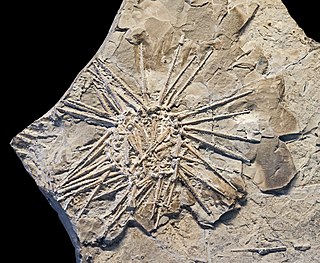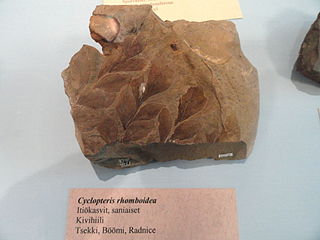Related Research Articles
Alaoceras is an ammonoid cephalopod from the upper Paleozoic included in the goniatitid family Cravenoceratidae, named by Ruzhentsev & Bogoslovskaya in 1971.
Rhabdoderma is an extinct genus of coelacanth fish in the class Sarcopterygii. It lived in the Carboniferous and Early Triassic, and its fossils have been found in Europe, Madagascar and North America.
Screbinodus is a genus of rhizodont lobe-finned fish that lived during the Carboniferous period.
Limnerpeton is an extinct genus of dissorophoidean euskelian temnospondyl within the family Amphibamidae.
Lochmocercus is an extinct genus of prehistoric coelacanth fishes which lived during the Carboniferous Period.
Sagenodus is an extinct genus of prehistoric lungfish. It is a lungfish from the Permo-Carboniferous period found in Europe and North America.

The Canyon Group is a geologic group in Texas. It preserves fossils dating back to the Carboniferous period. It contains the Caddo Creek, Graford, Palo Pinto, Wolf Mountain Shale and Winchell Formations.
Quasicravenoceras is a genus of ammonites in the goniatitid family Cravenoceratidae from the Carboniferous of Russia and Kazakhstan, included in the Neoglyphiocerataceae. The type species is Quasicravenoceras consuetum Ruzhencev & Bogoslovskaya, 1971.
Quasintoceras is a genus of goniatitid ammonites from the Lower Carboniferous Visean included in the Intoceratidae of the Pericyclaceae, now Pericycloidea.
Quinnites is a genus of gonititid ammonites included in the gastrioceratacean family Reticuloceratidae known from the Carboniferous of the state of Arkansas, USA.
Ceccaisculitoides is an extinct genus of ammonoids in the family Paragoceratidae. The genus name is a tribute to Fabrizzio Cecca, researcher at Pierre-and-Marie-Curie University, Paris.
Phragmolites is an extinct genus of molluscs in the family Bucaniidae, paleozoic molluscs of uncertain position possibly being either Gastropods or Monoplacophorans in the superfamily Bellerophontoidea.

Cyclammina is a genus of foraminifers in the family Cyclamminidae. Most species are extinct, but there are a few that are extant.
Cystodictya is an extinct genus of prehistoric bryozoans in the extinct family Cystodictyonidae.

Cyclopteris is an extinct genus of seed ferns in the extinct family †Cyclopteridaceae. Species are from the Carboniferous.

Bauruemys is an extinct genus of turtles in the family Podocnemididae.

The Ganigobis Formation is a Late Carboniferous (Gzhelian) to Early Permian (Artinskian) geologic formation of the Dwyka Group in the ǁKaras Region of southeastern Namibia and the Northern Cape of South Africa. The widespread formation was deposited in the Aranos and Karoo Basins of southern Africa.
The Köpinge Sandstone is a highly calcareous and glauconitic sandstone geologic formation of the Vomb Trough in Skåne, southernmost Sweden. The formation dates to the latest early to middle late Campanian stage of the Late Cretaceous and has provided fossils of ammonites, belemnites, the shark Cretalamna borealis and the mosasaurid Tylosaurus, originally described as Hainosaurus. Ex situ occurrences in Pleistocene deposits have provided a dorsal vertebra of a possible elasmosaurid.
Arenila is an extinct genus of bothremydid pleurodiran turtle that was discovered in the Western Desert of Egypt. The genus consists solely of type species A. krebsi.
References
- ↑ Reviziya semeystva Dimorphoceratidae. VE Ruzhencev, MF Bogoslovskaya, Paleontologicheskiy Zhurnal, 1969
- ↑ V. E. Ruzhentsev and M. F. Bogoslovskaya. 1978. Namyurskii etap v evolyutsii ammonoidyey - Namurian stage, evolution of ammonoids. Trudyi paleontologicheskovo instituta 167:1-338
- ↑ "Fossilworks: Cancelloceras". fossilworks.org. Retrieved 17 December 2021.